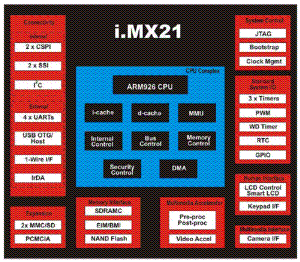Metrowerks debuts CELF-centered i.MX21 Linux BSP
Jul 8, 2004 — by LinuxDevices Staff — from the LinuxDevices Archive — 10 views Software development tools specialist Metrowerks announced a Linux board support package (BSP) for Freescale Semiconductor's soon-to-be-introduced i.MX21 multimedia applications processor. The i.MX21 targets wireless handheld products such as portable media players, smartphones, mobile gaming devices, and PDAs.
Software development tools specialist Metrowerks announced a Linux board support package (BSP) for Freescale Semiconductor's soon-to-be-introduced i.MX21 multimedia applications processor. The i.MX21 targets wireless handheld products such as portable media players, smartphones, mobile gaming devices, and PDAs.
(Click for larger image of i.MX21 reference platform)
The BSP, which Metrowerks says is based on code derived from the Consumer Electronics Linux Forum (CELF) Linux distribution, includes software components and tools for developing custom embedded Linux applications that run on the i.MX21 processor, Metrowerks says. The BSP provides CPU frequency scaling, kernel and application execute-in-place, dynamic and static power management, plus functions to “take full advantage” of the i.MX21 processor's multimedia functionality.
This Metrowerks BSP apparently represents one of the first commercial embedded Linux implementations — perhaps the first — to be derived from the CELF Linux distribution. Metrowerks says that four of its engineers have been participating in the development efforts of the CELF working group, and that it has contributed a number of patches to the CELF tree.
About the Freescale i.MX21 processor
The i.MX21 (MC9328MX21) multimedia applications processor is a recent addition to Freescale's i.MX processor family, which also includes the i.MX1 and i.MXL. The chip is based on a low power ARM926EJ-S processor core and currently supports 266-400 MHz operation. Other key features, according to Freescale, are:
- “Jazelle” technology for Java acceleration
- Enhanced video support with real-time MPEG-4 and H.263 encode/decode acceleration
- 3D graphics support through an external bus master interface to reduce overhead
- 16/18-bit color LCD controller with up to VGA resolution and “smart panels” support
- Interfaces: 4 UARTs, IrDA, AC97 host controller, and USB On-The-Go
- Expansion: dual-slot MMC and SD/SDIO card interface, plus PCMCIA support
- Enhanced security features including high assurance boot, security controller, hash accelerator, and memory management
- NAND Flash controller
- Fabbed in a 0.13 µm process and packaged in 289 ball, 0.65 mm pitch MAPBGA

i.MX21 Processor Block Diagram
(Click above image for a larger view)
About the Metrowerks i.MX21 BSP
According to Metrowerks, the i.MX21 BSP supports the following functions of the i.MX21 chip and its iMX21ADS reference platform board:
- On-chip Serial ports
- IrDA
- I2C
- DMA
- CMOS Sensor Interface (CSI)
- Ethernet
- LCD Video
- Touchscreen
- Keypad
- Memory devices, including Flash, DRAM, and SD Cards
- Timers and Watchdog
- Real-Time Clock
- PCMCIA
- Sound (stereo input and output)
Additionally, Metrowerks lists the following key features of the BSP:
- Enhanced Power Management (dynamic and static)
- Backlight brightness control
- Suspend/resume functionality
- CPU frequency scaling
- Backlight brightness control
- Quick Boot (< 500 mSec)
- Kernel and Application Execute in-place
- Integrated Linux Test Project suite
- JFFS2 and CRAMFS Flash Filesystem support
- Software:
- Linux kernel 2.4.20 (CELF release + i.MX21 additions)
- GLIBC Version 2.3.2
- GCC Version 3.3.2
- Various open source packages including the blob bootloader (with source) are also included
- Linux kernel 2.4.20 (CELF release + i.MX21 additions)
GUIs galore
Recognizing the graphical dimension to many i.MX21-based device applications, Metrowerks includes two licensable graphical application environments with its i.MX21 BSP.
 The BSP includes a “fully demonstratable” version of its PowerParts graphical application framework. (Click the image at the right for a larger view.) PowerParts is described as a library of C++ source code and functions that generate graphics primitives such as lines, rectangles, bitmaps, circles, ovals, arcs, text, and regions of arbitrary shape, and it supports 32-bit color, double buffered drawing and LCD screen rotation. A full-featured PowerParts library footprint is said to require less than 500KB of code, and can even be as light as 50KB of code, depending on features required. Additionally, a binary version of Metrowerks's PowerPlay multi-media player and underlying framework supporting MP2 (QCIF), MP3, MP4, JPEG (“with more coming”) is also included in the BSP.
The BSP includes a “fully demonstratable” version of its PowerParts graphical application framework. (Click the image at the right for a larger view.) PowerParts is described as a library of C++ source code and functions that generate graphics primitives such as lines, rectangles, bitmaps, circles, ovals, arcs, text, and regions of arbitrary shape, and it supports 32-bit color, double buffered drawing and LCD screen rotation. A full-featured PowerParts library footprint is said to require less than 500KB of code, and can even be as light as 50KB of code, depending on features required. Additionally, a binary version of Metrowerks's PowerPlay multi-media player and underlying framework supporting MP2 (QCIF), MP3, MP4, JPEG (“with more coming”) is also included in the BSP.
 The second graphical application framework comes in the form of a binary version of Trolltech's Qtopia Phone Edition (QPE) software. According to Trolltech, QPE encompasses a comprehensive suite of applications, customized to fit into a phone user interface, plus a “Home” screen that presents time critical data such as missed calls, messages received, and calendar events. The image at the left is the QPE user interface based on touch input only, for devices without keypads. An image of the keypad-based device UI alternative is here.
The second graphical application framework comes in the form of a binary version of Trolltech's Qtopia Phone Edition (QPE) software. According to Trolltech, QPE encompasses a comprehensive suite of applications, customized to fit into a phone user interface, plus a “Home” screen that presents time critical data such as missed calls, messages received, and calendar events. The image at the left is the QPE user interface based on touch input only, for devices without keypads. An image of the keypad-based device UI alternative is here.
Both of the above graphical application frameworks are available for license under separate arrangements.
Availability
Metrowerks says that as a subsidiary of Freescale Semiconductor, it “collaborated extensively with the i.MX21 hardware engineering team to deliver an integrated and optimized Linux development solution designed to leverage the processor's key features, including low power consumption, security, video, and multimedia capabilities.”
Metrowerks offers basic BSPs for the Freescale i.MX applications processors free of charge for download on its website. The free i.MX21 BSP is expected to be available at the same time the production silicon becomes available. The new Metrowerks i.MX21 BSP replaces a previously released BSP that supported Freescale's i.MX21 alpha silicon. Additionally, Metrowerks sells advanced development and support services for the package.
This article was originally published on LinuxDevices.com and has been donated to the open source community by QuinStreet Inc. Please visit LinuxToday.com for up-to-date news and articles about Linux and open source.